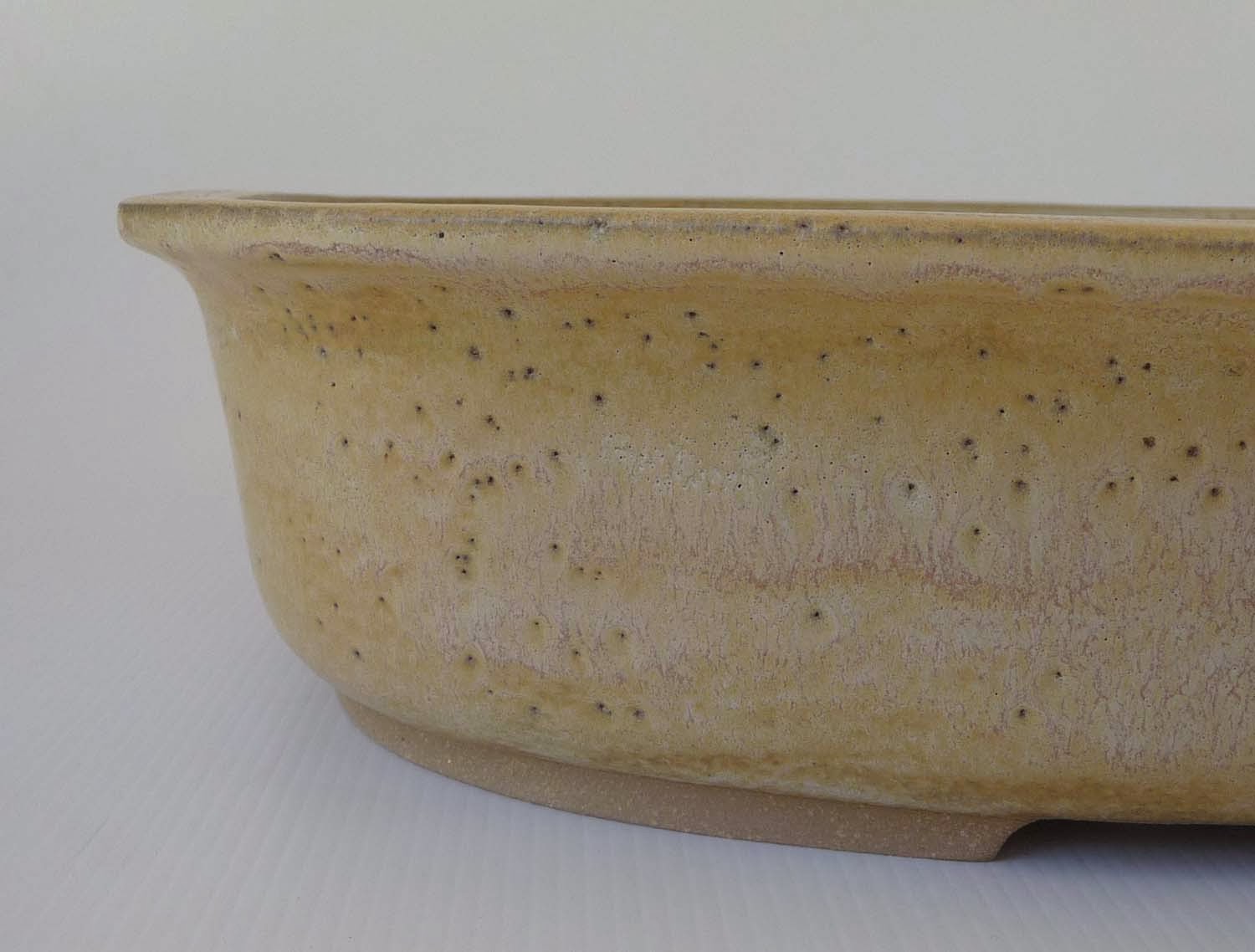My latest firing has been a very interesting one, with a couple of new experiments.
The first one was with Pot No 102. This is quite a large pot coming in at 452 x 352 x 82.
The glaze is a layering of two different glazes, which can produce some unexpected results. The base glaze is a favourite of mine that I have used often. It is the cream beige that breaks brown/red where thin, as on Pot 87. Over that glaze I've applied one of a differrent composition which has an antique, thoroughly offwhite colour that is a bit hard to describe., last used on Pot 91. Both of these were in a firing that featured on Post 124.
The base glaze is a Custer Potash glaze and the upper one is made on Nephylene Syenite. In the melting process the lower glaze generates gases which bubble when they get trapped by the over glaze, until they break out leaving an indentation. The glaze is fairly immobile so this causes some interesting surface movement without flowing.
Here is a detail shot which shows some the the results of that interaction between the glazes, leaving a very interesting colouring and surface. This one is a keeper.
I've talked about the different shapes of pots before. It is hard to tell what they are with the low angle side shot. Pot 102 is one of my compound ovals. In Post 123 I showed a picture of a few bisque pots, some compounds and a couple of ovals.
Here is a three quarters view which best shows off the pot. The reason I mention shape is because today's last pot is of a slightly different shape; but we'll come to that.
The next pot, Pot No 103 finished at 433 x 344 x 92 is another compound oval. This is one of my unglazed simulator glazes which I've used a bit recently, last time on Pot 98 posted in December. It can produce a variety of colours depending on how thick and uniformly the glaze is applied.
So that brings us to the last one for this firing, Pot No 104 at 389 x 280 x 76, just a little smaller than the other two.
First off let's have a top down look to show the difference in shape from Pot 102. Might just be just me but there is a difference, less bowing in the front and back walls and tighter radius corners, to make it a bowed wall rectangular pot.
The full frontal view shows another 'first use on a pot' glaze which I will add to my unglazed simulators; hence the application on the feet as well. It is a dark brown, just as expected with a nice little differentiation through the application.
And the end view.
And a three quarters view again to emphasize the different shape; makes an attractive pot.
And finally a detail shot of the glaze.
The first one was with Pot No 102. This is quite a large pot coming in at 452 x 352 x 82.
The glaze is a layering of two different glazes, which can produce some unexpected results. The base glaze is a favourite of mine that I have used often. It is the cream beige that breaks brown/red where thin, as on Pot 87. Over that glaze I've applied one of a differrent composition which has an antique, thoroughly offwhite colour that is a bit hard to describe., last used on Pot 91. Both of these were in a firing that featured on Post 124.
The base glaze is a Custer Potash glaze and the upper one is made on Nephylene Syenite. In the melting process the lower glaze generates gases which bubble when they get trapped by the over glaze, until they break out leaving an indentation. The glaze is fairly immobile so this causes some interesting surface movement without flowing.
Here is a detail shot which shows some the the results of that interaction between the glazes, leaving a very interesting colouring and surface. This one is a keeper.
I've talked about the different shapes of pots before. It is hard to tell what they are with the low angle side shot. Pot 102 is one of my compound ovals. In Post 123 I showed a picture of a few bisque pots, some compounds and a couple of ovals.
Here is a three quarters view which best shows off the pot. The reason I mention shape is because today's last pot is of a slightly different shape; but we'll come to that.
The next pot, Pot No 103 finished at 433 x 344 x 92 is another compound oval. This is one of my unglazed simulator glazes which I've used a bit recently, last time on Pot 98 posted in December. It can produce a variety of colours depending on how thick and uniformly the glaze is applied.
So that brings us to the last one for this firing, Pot No 104 at 389 x 280 x 76, just a little smaller than the other two.
First off let's have a top down look to show the difference in shape from Pot 102. Might just be just me but there is a difference, less bowing in the front and back walls and tighter radius corners, to make it a bowed wall rectangular pot.
The full frontal view shows another 'first use on a pot' glaze which I will add to my unglazed simulators; hence the application on the feet as well. It is a dark brown, just as expected with a nice little differentiation through the application.
And the end view.
And a three quarters view again to emphasize the different shape; makes an attractive pot.
And finally a detail shot of the glaze.










No comments:
Post a Comment
Happy to hear your advice, feedback or questions